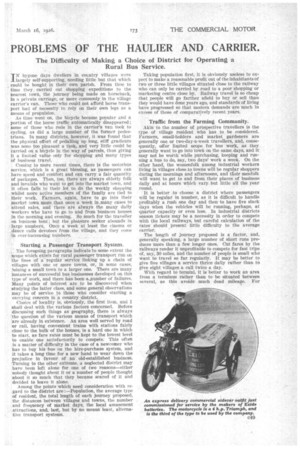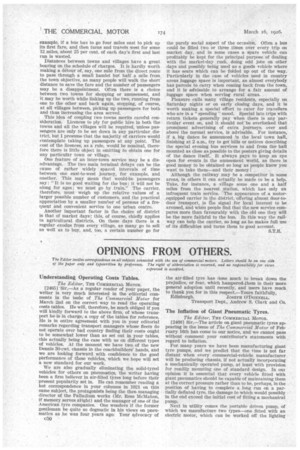PROBLEMS OF THE HAULIER AND , CARRIER.
Page 55

Page 56

If you've noticed an error in this article please click here to report it so we can fix it.
The Difficulty of Making a Choice of District for Operating a Rural Bus Service.
IN bygone days dwellers in cosntry villages were largely self-supporting, needing little but that which , could be bought in their own parish. From time to time they carried out shopping expeditions to the nearest town, the journey being made on horseback, in a private carriage, or more commonly in the village carrier's van. Those who could not afford horse transport had a necessity to rely on their own legs as a means of propulsion.
As time went on, the bicycle became popular and a portion of the horse traffic automatically disappeared ; some of those who rode in the carrier's van took to cycling, as did a large number of the former pedestrians. in many districts, however, it was found that the physical effort of pedalling up long, stiff gradients was none too pleasant a task, and very little could be Carried on a bicycle in. the way, of parcels, thus giving it a limited value only for shopping and many types of business travel.
Coming to more recent times, there is the motorbus service, which is a great blessing, as passengers can have speed and comfort and can carry a fair quantity of packages. Then, too, there are always elderly folk and invalids who want to get into the market town, and it often falls to their lot to do the weekly shopping whilst more active members of the family are tied to their. work. Farmers,. again, have to go into their market town suore than once a week in ,many cases to attend sales, and there are always the many daily workers who have togoto and from business houses in the morning and evening. So much for the traveller on business bent.; but the pleasure . seeker abounds in large numbers. Once a week at leaSt the cinema or :dance calls deVotees; from the village, and they come In ever-increasing numbers.
Starting a Passenger Transport System.
The foregoing paragraphs indicate To some extent the -s.
scope which exists for rural passenger -transport run on the lines of 'a regularservice linking up a chain of villages with one or more towns, or, in some cases, joining a small town to a larger one. There are many instances of successful bus businesses developed on this type of work, and there has been ELI:lumber of failures. Many points of interest are to be discovered when studying the latter class, and some general observations may be of service to those who consider starting a carrying concern in a country district.
Choice of locality is, obviously, the first item, and I shall deal with the various factors concerned. Before discussing such things as geography, there is always the question of the various means of transport which are already in existence. An area well served by road or rail, having convenient trains with stations fairly close to the bulk of the houses, is a hard one in which to start, as fare rates must be kept to the lowest level to enable one satisfactorily to compete. This often is a matter of difficulty in the ease of a newcomer who has to buy his bus on the hire-purchase system, and it takes a long time for a new hand to wear down the 'prejudice in favour of an old-established business. Turning to the other extreme, a neglected district may have been left alone for one of two reasons—either nobody thought about it or a number of people thought about it so much that they became seared of it and decided to leave it alone.
Among the points which need consideration with regard to the district are :—Population, the average type of resident, the total length of each journey proposed, the distances between villages and towns, the number and frequency of market days, the local amusement attractions, and, last, but by no mean§ least, alternative transport systems.
Taking population first, it is obviously useless to expect to make a reasonable profit out of the inhabitants of two or three little villages situated close to the railway who can only be carried by road to a poor shopping or marketing centre close by. Railway travel is so cheap that people will go farther afield to buy or sell than they would have done years ago, and standards of living have progressed so that modern demands are much in excess of those of comparatively recent years.
Traffic from the Farming Community.
Akin to the number of prospective travellers is the type of village resident who has to be considered. Farmers, small-holders and market gardeners are generally one or two-day-a-week travellers, and, consequently, offer limited scope for bus work, as they generally want to go into town on the same days, and it may not be worth while purchasing, keeping and running a bus to do, Say, two days' work a week. On the other hand, the womenfolk among industrial workers living in villages close to towns will be regular shoppers during the mornings and afternoons, and their menfolk will want to get to and from their places of business daily and at hours which vary but little all the year round.
It is better to choose a district where passengers will be regular in number, as it is difficult to handle profitably a rush one day and then to have five slack days when the vehicles will be running, perhaps, at quarter capacity or even less. In industrial districts season tickets may be a necessity in order to compete with the local railways, but careful calculation of the rates should present little difficulty to the average carrier.
The length of journey proposed is a factor, and, generally speaking, a large number of short runs produces more than a few longer ones. Cut fares by the railways render it unprofitable to compete for fast trips of, say, 30 mites, and the number of people is small who want to travel so far regularly. It may be better to give five villages a service thrice daily rather than to give eight villages a call twice a day.
With regard to termini, it is better to work an area from a terminus rather than to be situated between several, as this avoids much dead mileage. For example, if a bus has to go four miles east to pick up its first fare, and then turns and travels west for some 12 miles, about 25 per cent, of each day's first and last run is wasted.
Distances between towns and villages have a great bearing on the schedule of charges. It is hardly worth making a d&our of, say, one mile from the direct route to pass through a small hamlet but half a mile from, the town objective, as many people will walk the short distance to save the fare and the number of passengers may be a disappointment. Often there is a choice between two towns for shopping or amusement, and it may be worth while linking up the two, running from one to the other and back again, stopping, of course, at all villages between, picking up passengers for both and thus increasing the area served.
This idea of coupling two towns merits careful consideration. Licences to ply for public hire in both the towns and all the villages will be required, unless passengers are only to be set down in any particular, district, but I presume that the majority of carriers would contemplate taking up passengers at any point. The cost of the licences, as a rule, would be nominal, therefore there is little object in omitting to obtain one for any particular town or village.
One feature of an inter-town service may be a disadvantage. The two main terminal delays can be the cause of rather widely spaced intervals of time between one east-to-west journey, for example, and another. This may mean that would-be passengers say: "It is no good waiting for the bus; it will not be along for ages; we must go by train." The carrier, therefore, must weigh up the relative values of a larger possible number of customers, and the practical appreciation by a smaller number of persons of a frequent and convenient service to one urban centre.
Another important factor in the choice of district is that of market days; this, of course, chiefly applies to agricultural districts. On these days there is a regular exodus from every village, as many go to sell as well as to buy, and, too, a certain number go for the purely social aspect of the occasiOn. Often a bus could be filled two or three times over every trip on market day, and in some cases a spare vehicle can profitably be kept for the principal purpose of dealing with the market-day rush, doing odd jobs on other days and possibly being used as a goods vehicle where it has seats which can be folded up out of the way. Particularly in the case of vehicles used in country areas luggage space is important, as almost everybody has parcels to carry when coming back from the town, and it is advisable to arrange for a fair amount of luggage space when serving rural areas.
Pleasure calls many village residents, especially on Saturday nights or on early closing days, and it is worth making a special effort to cater for travellers who are in a "spending" mood. Special late trips with return tickets generally pay when there is any particular event on, and it should nor be overlooked that prominent advertising of extra journeys, over and above the normal service, is advisable. For instance, if a big dance be announced !n the local town hall, finishing at 2 a.m., try to get bills or notices describing the special evening bus services to and from thehall mounted as close as possible to the posters giving details of the dance itself. It always pays to keep an eye open for events in the amusement world, as there is good money to be obtained so long as people know you want to take them—and their money !
Although the railway may be a competitor in some areas, in others it can actually be made to be a help. Take, for instance, a village some one and a half miles from the nearest station, which has only an infrequent train service. The appearance of a motorequipped carrier in the district, offering almost door-todoor transport, is the signal for local interest to be aroused, and when people find that the new service compares more than favourably with the old one they will be the more faithful to the bus. In this way the railway can help the carrier, so long as he makes full use of its difficulties and turns them to good account. ,
S.T.R.


























































